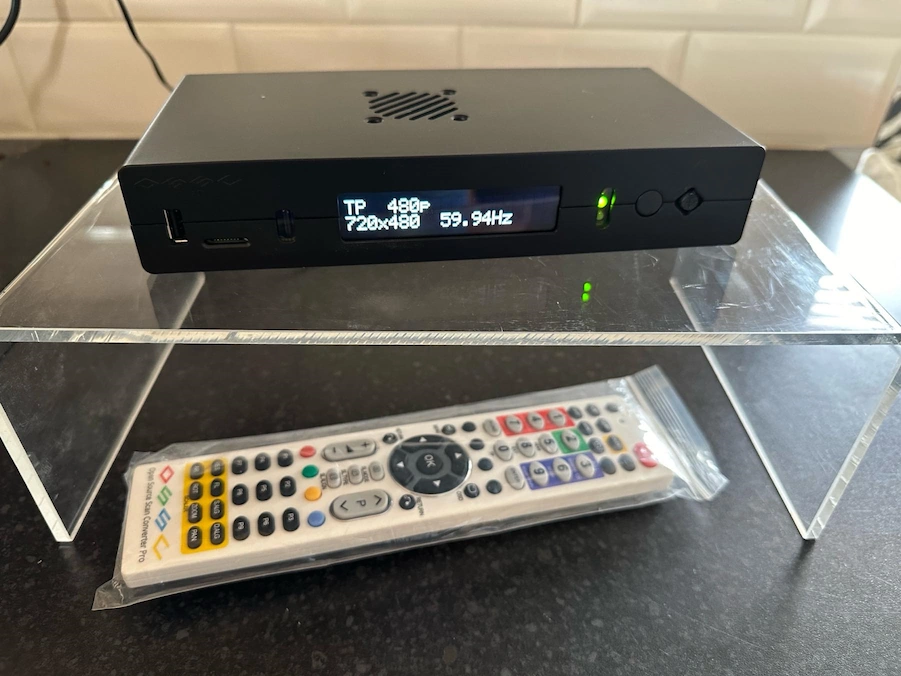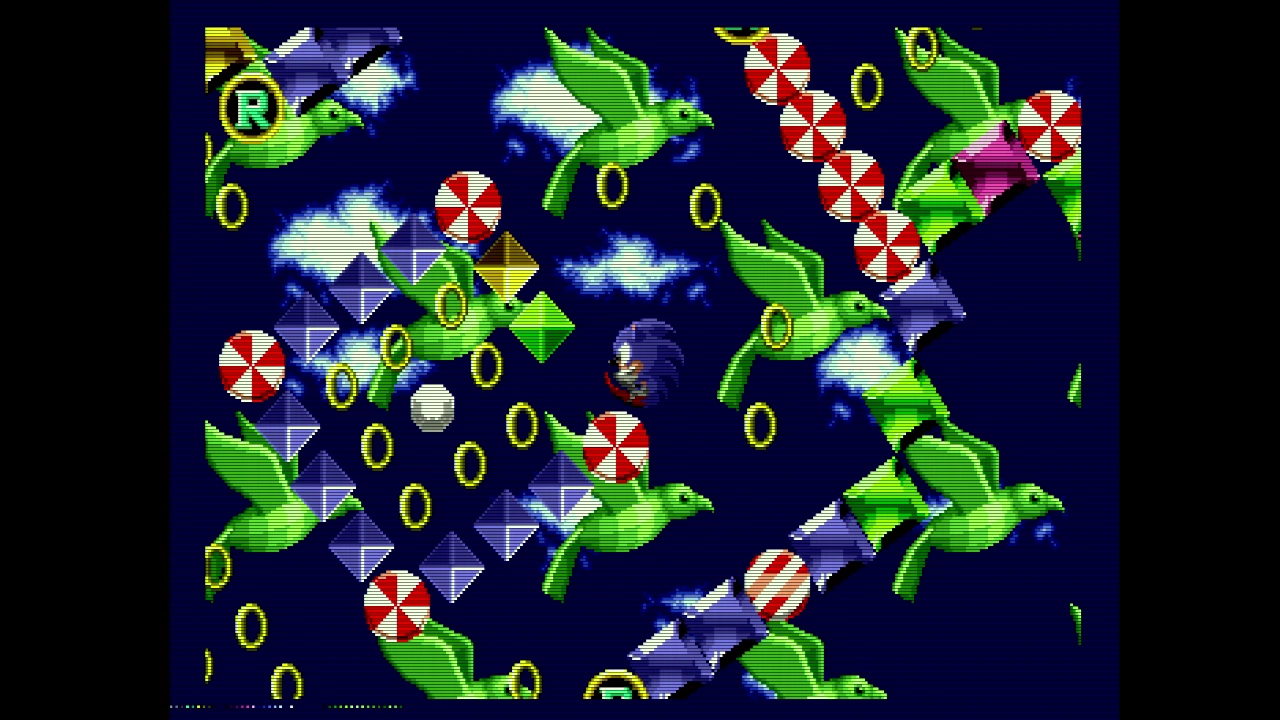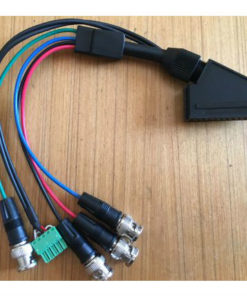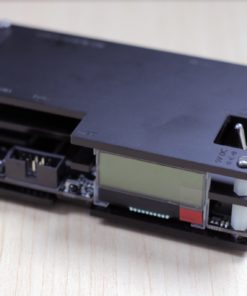Open Source Scan Converter (OSSC) Pro
€290.00
€290.00 incl. VAT
VAT inclusive price is estimated based on the geolocation of your browser and may be subject to recalculation at checkout. What's VAT?
OSSC Pro, remotes and PSUs are all in stock and available for immediate dispatch.
Important! – We give you the option to purchase the OSSC Pro without power supply unit (PSU) or remote, so that you can use suitable replacements you may already have yourself. Please note the specs of the required PSU carefully. You require a unit that outputs DC 5V with at least 2.5 amps. The tip must be 2.1 x 5.5mm and centre positive. Do not use a PSU that outputs more than 5 volts! Although OSSC Pro includes over voltage protection, damage can still occur if excessive voltage is applied for too long. Please note that damage caused by using an incorrect PSU is not covered under the warranty.
Use of the classic OSSC PSU with the OSSC Pro is not recommended! The classic OSSC PSU does not output enough amps and may cause the OSSC Pro to crash or reset during use.
Customers in Asia please note – RGB cables are wired slightly differently in your region (despite having the same physical connectors). If you want to use JP21 RGB cables with your OSSC, please also order a JP21 adapter. This adapter is NOT required for the more common Euro SCART cables (as purchased from Retrogamingcables.co.uk, Retro Console Accessories or most dealers in the EU, Australia and America).
The wait is over, the next generation Open Source Scan Converter has arrived. Retaining all the functionality of the original OSSC Classic, the OSSC Pro adds new modes and features making it ideal for scaling or processing any video game source. Now, as well as lag free line multiplication, there’s a low lag scaler mode too, allowing for more sophisticated scaling and processing.
What does it do?
Processes (line doubles) retro games with NO input lag – Unlike other scalers, such as the XRGB Mini, the OSSC Pro can work on individual scanlines rather than a frame at a time, that means there’s no input lag whatsoever (well, a few nanoseconds if you really want to be precise).
Adaptive line multiplication – OSSC Pro’s new adaptive line multiplier adds no more than 4 milliseconds of latency compared to the original, ‘pure’ line multiplication mode. Adaptive mode improves display compatibility and offers more flexible output options.
True next generation video scaler – OSSC Pro also includes a full video scaler mode, allowing you to upscale and downscale to a wide range of supported resolutions. Get the best out of ALL of your displays with the OSSC Pro. Go for a super sharp integer scale, or a softer, more CRT like look, the choice is yours. TV incompatibilities which plagued the OSSC Classic are a thing of the past with the devices new super flexible scaling engine, that continues to improve and evolve. Scaler mode can also prevent picture drop-out in games which switch between 240p and 480i.
Eliminates ugly deinterlacing artefacts and bad scaling – Connect most retro consoles to your TV and if you get a picture at all, it’s likely to be ugly. Bad scaling combined with deinterlacing (which should never even be applied to 240p material) will ruin the picture and make you wish you had your old CRT back. Well, worry no more! OSSC converts the image into a perfectly scaled image that is correctly displayed and processed. EVERY special effect, from 240p drop shadows to striped sprites, is rendered correctly.
Deinterlace your way – OSSC Pro’s scaler mode includes a motion adaptive deinterlacer, that aims to give the best compromise between input lag and picture quality. PS2 is no longer the Achilles heel of the OSSC! OSSC Pro can process this classic console using its motion adaptive deinterlacer. Bob and pass through modes are still available of course and OSSC pro can also convert 480i to 240p.
Digital video in – OSSC Pro features both digital video inputs and outputs. Now you can scale and process consoles such as the Xbox 360. It’s also ideal for use with consoles modded with RetroGEM or similar digital video output mods. Note that OSSC Pro does NOT support copy protected/HDCP sources.
Optimal presets for many common consoles with automatic phase detection – For those who love sharp pixels, OSSC Pro has optimal presets and an “auto phase” function that means you do not have to dial in phase using a chequerboard grid like with OSSC classic. For sources where manual adjustment is needed there is the ability to manually override and dial in phase adjustments by hand if required.
Advanced filters and post processing – Going beyond what was possible on a line doubler, OSSC Pro can add all kinds of amazing post processing filters. Go for the super sharp look of crispy pixels, or create that perfect classic CRT look on your modern flat panel display.
Polyphase scaler coefficients (compatible with Mister) – Download filters, scanline effects etc. directly from the Mister repositories and add them to the SD card, or create your own and share the files with the community.
Black frame insertion – Get closer to that perfect CRT like picture with black frame insertion. OSSC Pro can frame convert your 60hz content to 120hz and insert black frames between each screen refresh, improving motion clarity.
HDR Injection – Post processed image too dull? Turn on HDR injection mode and restore lost brightness (requires HDR capable display, gamma curve may be affected).
Downscale – OSSC Pro is currently the most flexible downscaler on the market. Paired with a simple HDMI to VGA or component transcoder (or planned expansion card), OSSC Pro turns your classic CRT into a retro-power house. Downscale modern retro inspired titles to 240p, 288p (PAL 50/60) or 480i. No need to worry if you lose the image choosing an incorrect or incompatible resolution, simply use the built in OLED display on the front of the unit to choose a different one.
Flexible size and position controls – OSSC Pro’s scaler mode allows you to crop, resize and scale the image however you want to.
Easily save, load and share profiles – Using a standard FAT32 formatted MicroSD card, no longer is there a need for special tools for saving or sharing profiles. The new OSSC Pro profiles are designed to be more compatible between firmware versions, meaning less time wasted re-configuring profiles after a firmware update.
OSSC Pro does not support composite video (three RCA, one for picture two for sound) or S-video connections unless used with this expansion card or with a Koryuu or similar converter. OSSC Pro is optimised for video games not movie content.
Documentation, support and returns
In addition to the standard 1 year EU warranty, we’re also giving a one-month no quibble return for all units. Test the OSSC Pro in your setup and if it doesn’t work, return it to us for a full refund. All we ask is that you pay return postage and send the complete unit with packaging and any accessories undamaged. Contact us here if you need to return a unit.
Technical specs
Inputs
- 1 X SCART – Supports RGBs (clean csync 75ohm), cvideo sync, luma sync, RGsB, YPbPr (RGBHV and RGBCS TTL can be connected via an adapter)
- 1 X Component video – Supports YPbPr and RGsB signals
- 1 X Analogue audio RCA (2 x RCA for left and right channels, supports all analogue audio)
- 1 X D-SUB15 (VGA) – Supports RGBHV, RGBCS (TTL level voltage), RGsB, YPbPr (75ohm RGBs sync can be connected via an adapter)
- 1 x Optical audio (LPCM2.0 and DD5.1/DTS bitstreams)
- 1 x Digital video input (standard input compatible with most sources, supports up to LPCM7.1 or DD5.1/DTS audio input)
- 1 x 3.5mm analogue audio – Supports all analogue audio.
- Composite video and S-Video are NOT natively supported and require an adapter/transcoder or expansion card
Outputs
- 1 X HDMI or DVI-D (with adapter) (digital only, including audio). Full-range 24-bit RGB output through DVI/HDMI
- Output to analogue (e.g for CRT) requires a transcoder or expansion card (coming soon)
Supported input resolutions
- 240p/288p/480i/576i 15khz
- 25khz medium-res modes
- 480p/576p/720p/1080i/1080p 31khz
- Common PC resolutions up to 1600×1200
Supported output resolutions
- From 240p to up to 2560×1440@60hz output (or to 2880×2160@60hz with pixel repetition)a720p@120hz and 1080p@120hz modes, the latter with different presets to allow selection between performance and compatibility. See the Wiki for more details
- 240p to 1080i output modes for classic CRTs
Other features
- Character OLED display
- SD Card socket for firmware updates, additional profile storage and custom scaling algorithms and shadow masks
- JTAG connector
- IR receiver
- Expansion connector
- USB port (for controlling external devices, attaching game controllers and other future possibilities, please note these functions are not yet implemented)
- Front mounted joystick allows for full operation of the unit if IR remote control is lost or misplaced
Power requirements
- DC 5V 2.5 amp – 2.1 x 5.5mm positive tip
Related
| Weight | 900 g |
|---|---|
| Dimensions | N/A |
| Accessories? | Multi-region PSU & Remote, Multi-region PSU, Remote & JP21 adapter, Remote only, Multi-region PSU only, No accessories |
| hscode | 8521900000 |
| Customs Description | Video signal converter |
| Country of Origin | CHN |
1 review for Open Source Scan Converter (OSSC) Pro
Add a review Cancel reply
Related products
AV Cables
€28.90
€28.90 incl. VATOSSC
€85.00
€85.00 incl. VAT€0.50
€0.50 incl. VAT€80.00
€80.00 incl. VAT€32.00
€32.00 incl. VAT€11.00
€11.00 incl. VAT€6.50
€6.50 incl. VATMisc mods/repairs
€31.50
€31.50 incl. VAT
























Sean –
I’ve only tested the downscaling feature, which is why I bought this device. It works very well using a generic HDMI to VGA converter and an RGBHV to S-Video adapter. My only complaint is I wish there was a native S-Video output. But I won’t take a star off for that because I bought it knowing it didn’t have that.